Fungi of New Zealand series
In this section
-
Publications
- Annual reports
- Capability factsheets
- Ecosystem services in New Zealand
- Fauna of New Zealand series
- Fungi of New Zealand series
- Innovation Stories
- Insect factsheets: Interesting insects and other invertebrates
- Kararehe Kino – Animal Pest Research
- Minimising environmental impacts of mining
- Naturally Uncommon Ecosystems
- Poisonous plants
- Policy briefing & guidance papers
- Pūtaiao - Manaaki Whenua science summary
- Science Series
- Soil Horizons
- Statement of Corporate Intent
- Te Āpōpōtanga – Our land, our people, our future
- Te reo o te repo: The voice of the wetland
- Te reo o te repo – kei konei tonu au: The Voice of the Wetland – I am still here
- VSA field guide
- Weed Biocontrol newsletter
- Woody ecosystem types
- Working papers and reports
- Wetland Handbook Series
- Wetland Restoration
- Subscribe to newsletters & updates
- Gender and Ethnicity Pay Gap
Ko te wāhanga haere tonu "Ngā Harore o Aotearoa" he whakamārama me te āta arowā i ngā rōpū harore tae atu ki te hātepe tautuhi me te waitohu kaiao, ngā whakaaturanga, me ngā pikitia. He whānui te tautuhi i te Harore, kia uru mai te harore tūturu (Harore Mātāmuatanga) me ētahi atu rōpū kua roa nei e whakatakina ana e ngā kaimātai pūtaiao harore ahakoa, e whakaarohia ana i tēnei wā, he momo ēnei nō ngā Mātāmuatanga Chromista me te Protozoa. Kei roto ngā harore tūturu me ngā momo rāwaho. Kei roto in ngā kaituhi ētahi kaimātai pūtaiao harore o tāwāhi, e whakaata ana i te āwhina a ngā rāwaho ki te whakataki harore o Aotearoa.
Series Preface - English
The fungi of New Zealand are an intriguing and significant part of New Zealand's biodiversity. Geographic isolation for over 50 million years has resulted in distinctiveness in almost all groups of the biota, and the fungi are certainly no exception. The conspicuous flower fungus Aseroe rubra and sky-blue mushroom Entoloma hochstetteri, both featured in the Maori design on the cover, are but two of many iconic species. The indigenous Maori of New Zealand have several traditional uses of selected species of fungi spanning food, medicine, tinder, and ornamentation.
Fungi comprise the threads that bind ecosystems together. Fungi are the great recyclers, causing decomposition of dead plant and animal material and thereby releasing nutritive products to other organisms. There are also many fungi associated with living plants and animals. Most plant diseases are caused by fungi, and the risk of new diseases entering New Zealand is a major focus for border control agencies. With most exports based on primary products (timber, fruit, meat, wool, dairy products), control of fungal diseases of cultivated plants and animals is an imperative for New Zealand. The other main kind of fungal association with living plants is a mutually beneficial, mycorrhizal relationship between fungus and plant roots; fungi assist most plants to absorb nutrients from the soil while themselves receiving carbohydrates produced by photosynthesis in the plant's leaves.
Fungi have been studied scientifically by New Zealand mycologists, sporadically during the late 19th Century and intensively since the early 20thCentury; however, their high numeric diversity (expected to exceed 20,000 species) means that probably three quarters of New Zealand's fungal species remain to be recorded. Landcare Research, along with its predecessor organisation Department of Scientific and Industrial Research (DSIR), has a significant commitment to mycological research and is custodian of the New Zealand Fungal Herbarium (PDD) and International Collection of Micro-organisms from Plants (ICMP), both collections located in Auckland.
The "Fungi of New Zealand / Ngā Kōpurawhetū o Aotearoa" series consists of monographs and definitive treatments of groups of fungi, including taxonomic keys, descriptions, and illustrations. The Fungi are defined in a broad sense, to include the true fungi (Kingdom Fungi) and other groups traditionally studied by mycologists although now considered to belong in the Kingdoms Chromista and Protozoa. Both indigenous and introduced fungal species are treated. Authors include overseas mycologists, reflecting the welcome contribution made to New Zealand mycology by many international collaborators.
Ngā Harore o Aotearoa. Kupu Whakataki
Ko ngā harore o Aotearoa, he wāhanga whakamere, he wāhanga tāpua hoki o te koiora kanorau o Aotearoa. Nā te noho motuhake o te whenua nei mō ngā tau 50 miriona neke atu rānei kua hipa, i puta ai te kōhure o ngā momo katoa o te huinga o ngā momo kararehe, tipu hoki o Aotearoa nei, ā, he pērā anō hoki ngā harore. Ko te harore putiputi, puapuatai me te harore kahurangi werewere kokako, e whakaaturia ana i roto i te tauira Māori kei te whārangi o mua, he momo e rua noa iho o ngā momo harore ata huhua. Kei te tangata whenua o Aotearoa ētahi tikanga tuku iho e pā ana ki te whakamahinga o ētahi o ngā momo harore mai i te kai, te rongoā, te whakakā ahi tae atu ki te whakapaipai.
Kei roto i te harore ngā aho e tuitui nei i te rauwiringa kaiao. Ko te harore te kaihangarua nui, e whakapirau ana i te tipu me te kararehe kua mate, nā reira e tuku ana i te whakamōmona ki ētahi atu kaiao. He maha ngā harore e hono ana ki ngā tipu me ngā kararehe. Ko te nuinga o ngā mate ā-tipu i taketake mai i ngā harore, ā, ko tētahi o ngā arotahi matua a ngā mana ārai, kei tūpono mai ētahi mate anō ki roto i tō tātau whenua. Nā te mea, ko te taketake o te nuinga o āna hokonga ki tai, he hua tuatahi (rākau, hua rākau, mīti, wūru, hua miraka kau), he mea tuatahi ki Aotearoa te whakahaere tika i ngā mate e pā ana ki ngā kararehe me ngā tipu e tāmatatia ana, i tīmata mai i te harore. Ko tērā atu hononga matua o te harore ki ngā tipu, he hononga tauawhiawhi, motuhake ki ngā aka; e āwhina ana te harore i te nuinga o ngā tipu ki te kai i te whakamōmona mai i te oneone i ngā harore e whiwhi ana ki ngā warowaihā ka puta mai i te pātātoko o ngā rau o te tipu.
I whakatakina te harore e ngā kaimātai pūtaiao harore o Aotearoa nei, i ētahi wā i te rautau 19, ā, mai i te tīmatatanga o te rautau 20 ka kaha kē ake te whakataki a te hunga kaimātai pūtaiao; engari, nā te maha rawa o ngā momo harore (ko te whakapae, ka eke atu i te 20,000 ngā momo harore) he hauwhā noa iho o ngā momo harore kua tuhia. Ko Manaaki Whenua, me tōna rōpū tōmua Te Tari Rangahau Pūtaiao, Ahumahi (DSIR), e herea ana ki te rangahau i te harore, ā, ko ia hoki te kaitiaki o te Kohikohinga Harore o Aotearoa (PDD) me te Kohikohinga Moromoroiti Tipu ā-Ao (ICMP), kei Tāmaki-makau-rau.
Ko te wāhanga haere tonu "Ngā Harore o Aotearoa" he whakamārama me te āta arowā i ngā rōpū harore tae atu ki te hātepe tautuhi me te waitohu kaiao, ngā whakaaturanga, me ngā pikitia. He whānui te tautuhi i te Harore, kia uru mai te harore tūturu (Harore Mātāmuatanga) me ētahi atu rōpū kua roa nei e whakatakina ana e ngā kaimātai pūtaiao harore ahakoa, e whakaarohia ana i tēnei wā, he momo ēnei nō ngā Mātāmuatanga Chromista me te Protozoa. Kei roto ngā harore tūturu me ngā momo rāwaho. Kei roto i ngā kaituhi ētahi kaimātai pūtaiao harore o tāwāhi, e whakaata ana i te āwhina o ngā rāwaho ki te whakataki harore o Aotearoa.
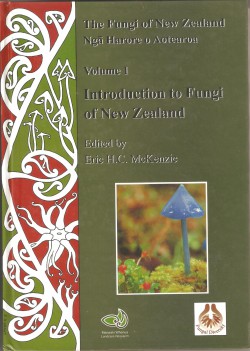
Introduction to Fungi of New Zealand – The Fungi of New Zealand volume 1
Volume 1: Introduction to Fungi of New Zealand
Edited by Eric HC McKenzie
New Zealand's fungi are rich in variety and host interactions, vast in number, and often unique to New Zealand. Yet an estimated two-thirds of the expected 22,000 species remain unrecorded.
This volume seeks to provide a foundation for understanding New Zealand's fungi, including taxonomic, ecological, historical, and cultural knowledge about fungi, along with inventories of recorded species.
This book represents a cooperative initiative by several New Zealand mycologists, in conjunction with a Swiss colleague.
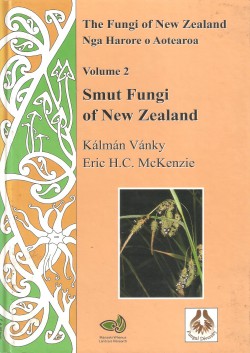
Smut Fungi from New Zealand – The Fungi of New Zealand volume 2
Volume 2: Smut Fungi of New Zealand
Kalman Vanky and Eric H.C. McKenzie
Smut fungi are microscopic lifeforms that grow as plant parasites. They are common on grasses, sedges, and rushes. Most smut fungi produce powdery spores that are dark-coloured, similar to the spot or smudge made by small flakes of soot.
In this monograph all 93 spcies of smut fungi known from New Zealand (plus one species found only in a quarantine, containment glasshouse) are described. Approximately 60% of the smut fungi in New Zealand are thought to have been introduced, in many cases accidently with seeds.
Most of the species are illustrated with line drawings of their habit on the host plants and by photomicrographs of their spores, taken by both scanning electron microscopy and light microscopy.
There is a key to the 25 genera of smut fungi known from New Zealand, and the 216 host/pathogen combinations in New Zealand are listed.
A Preface and Popular Summary are included with translations in Māori.
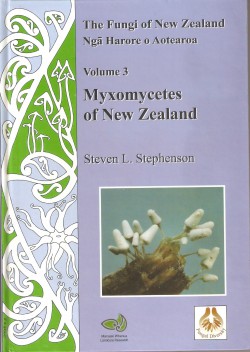
Myxomycetes of New Zealand – The Fungi of New Zealand volume 3
Volume 3: Myxomycetes of New Zealand
Steven L. Stephenson
This book aims to provide a comprehensive monographic treatment of the more than 180 species of myxomycete (plasmodial slime moulds) previously reported or known to occur in New Zealand.
Myxomycetes are a group of fungus-like organisms found in most terrestrial ecosystems. They tend to be overlooked because of their small size and the types of situations where they occur. Although "slime mould" is not a particularly attractive common name, the fruiting parts of the fungi often exhibit incredibly diverse forms and colours, and are often objects of considerable beauty.
An overview of the group is given, including aspects of their biology and ecology, along with an explanation of the basic structural features of the fruiting body upon which identification is based.
Dichotomous keys are provided to the different taxonomic orders of myxomycetes and to families, genera, and species within each of these orders. Each species is described, and selected examples are illustrated with line drawings and/or colour photographs.
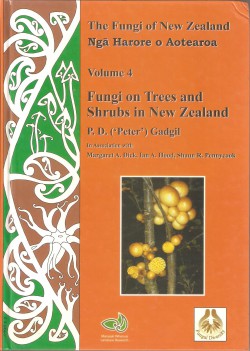
Fungi on Trees and Shrubs in New Zealand – The Fungi of New Zealand volume 4
Volume 4: Fungi on trees and shrubs in New Zealand
PD (Peter) Gadgil
In this book, some 700 fungi associated with trees and shrubs in New Zealand are described. They include pathogens of forest trees and horticultural crops, beneficial mycorrhizal fungi and saprophytes which live on dead portions of living plants. Short descriptions of life cycles of the major group of fungi included in the book are provided. For each fungus, a description of the organism, its distribution within New Zealand and its significance are given. The fungi are grouped according to the part of the plant on which they mainly occur and then according to their broad taxonomic group. There are also separate chapters on groups of fungi related in form or function: downy and powdery mildews, rusts and smuts, sooty moulds, and mycorrhizae. A list of host plants and their associated organisms is provided. There are colour illustrations of fruit bodies or disease symptoms of 90 fungi.
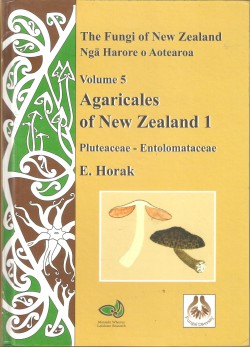
Agaricales of New Zealand 1: Pluteaceae – Entolomataceae – The Fungi of New Zealand volume 5
Volume 5: Agaricales of New Zealand 1 - Pluteaceae - Entolomataceae
E. Horak
This book provides descriptions and illustrations of all the species of the pink-spored agarics of the families Pluteaceae and Entolomataceae that have been recorded in New Zealand, both indigenous and exotic, as well as keys for the identification and details of herbarium specimens. Doubtful and excluded records are also annotated.
Two genera of Pluteaceae are covered: Pluteus (15 species, including 10 new species previously unnamed and undescribed); and Volvariella (three species). Six genera of Entolomataceae are covered:Claudopus (one species); Clitopilus (two unnamed species); Entoloma (76 species, including 28 new species); Pouzarella (one species); Rhodocybe (nine species, including one new species) and Richoniella (one species, including a new form).
